The black bike is pure American badass, styled like a prizefighter and with the same pugnacious manners. The platinum-colored bike is an exotic Italian beauty, long and lean with an undeniable air of exclusivity. Though the Buell 1125R and Aprilia RSV1000R appear very different on the surface, these stepbrothers from different moto-mothers both carry Rotax-made V-twins under their fairings. Do similar mechanical hearts make them more alike, or more distinct? We paired them off on the street and track to find out.
Although Aprilia is at the end of its 10-year agreement with Rotax and is currently developing its own V4 superbike in-house, the World Superbike-winning RSV1000R is still the firm's sporting flagship, and makes an excellent benchmark against which to judge the all-new Buell. The RSV is outpaced by modern sport-twins, such as the awesome Ducati 1098, but that's not surprising given that it's been largely unchanged since its 1998 release.
Not only does the 1125R carry Rotax's latest Helicon V-twin-the Austrian firm's second attempt at a superbike powerplant-but also a host of Buell-exclusive engineering innovations, including a fuel-bearing frame, split radiators and inside-out front brake. Our first ride on a pre-production 1125R at Laguna Seca last fall was inconclusive; comparing a production version against a proven performer is a great way to assess its real-world abilities.
Shared mechanical DNA aside, these two bikes couldn't be more different. The Aprilia represents conventional sportbike design theory, with typical chassis geometry, ergonomics and ride characteristics. The Buell, on the other hand, lives up to the company's old "Different in Every Sense" motto, with atypical geometry, unique ergos and distinctive handling characteristics.
Start in the saddle: Buell's Comfort Zone cockpit is one of the best in the business. The seat is broad, supportive and perfectly contoured, the bars are high and comfortably set, and there's plenty of legroom-the elusive all-day sportbike riding position. The Aprilia is a traditional Italian rack with a flat, firm saddle, long reach to low, narrow bars and high footpegs that will cramp anyone over 6 feet.
Straddling the RSV illustrates how much more compact sportbikes have become in the past decade. It feels massive, with a tall, wide tank that pries your legs apart and accentuates the bike's top-heaviness, especially at slow speeds. The Buell feels tiny by comparison. With its fuel carried lower and farther forward in the frame, the airbox cover between your legs is narrower and the footpegs are a few inches closer together. Combined with a bulbous fairing that moves air more like a Gold Wing than a GSX-R, the Buell offers undeniable comfort.
Despite being separated by 10 years of development and 12 degrees of cylinder angle (the Aprilia's cylinders are set at 60 degrees, the Buell's 72), there's no doubt both V-twins come from the same source. The two bikes sound nearly the same, with deep, growling exhaust notes and a surprising amount of mechanical clatter. Both also transmit a fair amount of vibration, especially at higher revs, despite aggressive counterbalancing measures (twin balance shafts for the 'Priller, three for the Buell). Vibration is especially noticeable through the Buell's footpegs, which mount directly to the engine cases.
Both bikes feel a tad thrashy at idle, but this impression disappears at speed. Except for a slight stumble off closed throttle, the Aprilia injects perfectly and offers smooth, linear acceleration from any rev point. Buell's DDFI 3 system is hugely improved compared with the pre-production units we tested at Laguna, but still not flawless. Gone is the off-idle abruptness, but the system still tends to hunt at constant throttle in the lower rev range and occasionally stumbles when you whack it open below 4000 rpm, causing the bike to lurch and shudder. A shame, this latter point, because the constant-tension drive belt and compensated countershaft sprocket combo otherwise provide lash-free forward motion.
Tim Carrithers, Dog-Eared Boy | Off The Record
I'd pick a winner here if we had one, but this conflict is a choice between bad and worse, a.k.a. the Aprilia. I loved the look. Very orange, very Italian and plenty of attitude. Then I rode it. Ergonomics by de Sade, an underwhelmingly asthmatic engine and limp suspension. I could muster up the time and money to deal with all that if we were talking about a well-preserved '98 Mille on eBay, but for a brand new $14,000 '08? There are too many other options out there.
Getting along with the Buell might be remotely possible if it didn't come with intractable fuel injection, a sticky gearbox, inconsistent brakes and only slightly less engine heat than a hibachi full of dry mesquite. But it does, so I can't.
AGE: 9.25 dog years HEIGHT: 6'3" WEIGHT: 15.35 stone INSEAM: 35 in.
The Buell is undeniably faster than the Aprilia, and not just because of its 125cc displacement advantage. Both motors share the same 67.5mm stroke, but the Buell's 6mm-larger pistons (103mm versus 97mm for the Aprilia) make room for bigger valves that, in conjunction with a downdraft intake arrangement, make for a freer-breathing motor that delivers lots more power at higher revs. The 1125R's 15.6-horsepower advantage (129.1 bhp at the rear wheel, compared to 113.5 bhp for the RSV) helped during quarter-mile testing, where it ran a stout 10.61 seconds at 135.91 mph against its rival's 10.95/129.91. The 1125R was also helped at the strip by its smooth-shifting, light-action transmission, far better than the Aprilia's stiff, notchy lever action. Admittedly, our RSV had just 600 miles on the clocks at the time of dragstrip testing; hopefully action will improve with more break-in miles.
More power also gave the Buell an advantage at Buttonwillow Raceway, where during a Track Riders () track day it consistently lapped a full second quicker. Once we got the suspension dialed-in, that is. During street testing the factory suspension settings exhibited a disturbing lack of front-end feedback and a tendency to run wide at corner exits-the same issues we encountered at the Laguna Seca press intro. With help from Dave Moss of Catalyst Reaction Suspension Tuning (www.feelthetrack.com), we backed fork spring preload out a full five turns to arrive at an acceptable 35mm of sag, and still had to increase rebound damping one turn to slow things down. The shock suffered the opposite problem: Even with rebound backed all the way out, it would pack up on bumpy corner exits and cause the bike to run wide.
The 1125R features a steep 21-degree rake and short 3.3 inches of trail (compared with the RSV's 25 degrees/4 inches), which gives it much quicker steering response. Perhaps to temper this quickness, the 1125R's clip-ons are cantilevered almost 3 inches in front of the fork tubes-an arrangement that seems to create a slight disconnect between steering input and turning action. We frequently found ourselves oversteering to initiate turns, and then having to correct mid-corner once the chassis finally caught up with our intentions.
Surface bumps tend to deflect the Buell off line, and with the oddly mounted handlebars amplifying every input, it took some attention to keep the bike pointed where we wanted to go. Couple this with the high-front/low-back chassis attitude and you're left with slightly vague feedback from the front end. Certainly the Buell can be ridden fast (1125Rs have already won club races in the states and abroad), but it lacks the quicker, confident handling of a conventional sportbike chassis.
The RSV offers more predictable handling. Equipped from the factory with an exotic 43mm Ohlins inverted fork paired with a pedestrian Sachs shock (don't let the gold color fool you), suspension action on the RSV is close to perfect right out of the box. Better suspension or not, though, the RSV's chassis shows its age when ridden back-to-back with the modern, mass-centralized 1125R. The taller, wider and heavier 'Priller takes significantly more effort to turn; riding the RSV hard wears you out fast.
Wonky steering traits aside, the American musclebike simply changes direction more easily than the Italian stallion, which makes it both quicker and less fatiguing to ride-especially at the track. The RSV does, however, offer adjustable rear ride height, which isn't available on the Buell. Unfortunately, we ran out of daylight before we could experiment with this at the track. But jacking up the rear of the RSV a bit might help it tip into corners with less effort.
One element that didn't need improving on the Aprilia was braking, thanks to the excellent Brembo radial-mount front calipers, which offered superior feel and easy modulation.
Barry Burke, Wing-Footed God | Off The Record
"The Aprilia might be 10-year-old technology, but the chassis still works pretty well. The Ohlins fork helps handling through the canyons, the Brembo brakes give good feedback and the Italian styling still looks classic. But the motor is just slow, especially compared to other liter-class sportbikes. However, if you're not looking for the ultimate speed machine, the RSV is still a good motorcycle with a solid chassis and lots of traditional V-twin character.
Buell's 1125R is closer to where it needs to be power-wise, but on every other point it's no comparison. As far as I'm concerned, the Aprilia smokes it in every category except outright acceleration. Beyond that, my mother always told me, 'If you don't have anything nice to say...'"
AGE: 44 HEIGHT: 6' WEIGHT: 165 lb. INSEAM: 33 in.
Buell's Zero Torsional Load front brake conversely leaves something to be desired. Even with eight pistons pressing down on a 375mm, rim-mounted rotor, the single front brake proved insufficient at the track, where heat-induced fade became an issue. By the end of our track day the rotor was burned blue and the pads howled in protest with each heavy stop. The ZTL brake is difficult to apply consistently, too: Initial bite is limp, causing you to squeeze the lever harder only to find yourself reducing brake pressure an instant later when the braking effect catches up.
Lapping Buttonwillow, the Buell was consistently quicker by a solid second, mostly by virtue of its stronger motor and ability to change direction quicker in the tight stuff. You can definitely turn a fast lap on the 1125R, but it takes decidedly more concentration and constant input than the more predictable, less demanding RSV. Both of these torquey, tractable twins are more at home on the street-especially the 1125R.
If you're willing to adapt your riding style to accommodate the Buell's quirks, you'll be rewarded with a fast, flexible and supremely comfortable streetbike. Aprilia's RSV1000R is an acceptable performer but a bit past its prime in terms of power output and handling prowess. Factor in the fact that the new bike costs $1000 less than the old one, and the 1125R is the clear winner. Rotax-and Buell-have learned a lot in the 10 years separating these two engine designs. It's time now for Aprilia to catch up.
Tech Spec
Contact
Buell Motorcycle Co.
2815 Buell Dr.
East Troy, WI 53120
262.642.2020
Tech Spec
Contact
Aprilia USA
140 E. 45th St.
New York, NY 10017
800.631.1101
2008 Buell 1125R | Price: $11,995
Engine
A 72-degree cylinder angle provides the straightest possible flow path for the intake charge. Innovative combination chain-and-gear cam drive and finger follower-actuated valves make the motor more compact and lighter in weight.
Chassis
Buell claims the Intuitive Response Chassis is the stiffest frame it has ever built, and 10 pounds lighter than the old XB-series frame. Like the XB, this frame doubles as a fuel reservoir, holding 5.3 gallons of dinosaur juice.
Suspension
The fully adjustable Showa fork is an oversized 47mm inverted unit for maximum rigidity. The Showa shock mounts directly between the frame and swingarm without a linkage, and uses a progressively-wound spring.
Brakes
Buell's exclusive Zero Torsional Load front brake mounts the rotor directly to the rim to isolate torsional forces and reduce unsprung weight. A single eight-piston caliper holds four pads that maximize surface area and heat dissipation.
Ergos
With a short seat-to-bar distance and generous handlebar rise, the 1125R is very upright for a sportbike. Seat-to-peg distance is nearly identical to the RSV, but the 1125R's more open included seating angle folds your legs less.
Dyno
High compression, big valves, high-lift cams and massive 61mm throttle bodies make for impressive output. Power barely falls off past the 9750-rpm peak; coupled with substantial midrange torque, shifting the 1125R is largely optional.
2008 Aprilia RSV1000R | Price: $13,999
Ergos
The RSV's riding position reflects its racing roots, with a long reach from seat to bars and minimal handlebar rise. It's tall, too: The seat-height measurement is with the rear ride-height adjuster set in the lowest position.
Dyno
A lackluster 113.5 peak horsepower won't win Aprilia's liter-twin any bragging rights, but a fat and flat torque curve (the motor is within 90 percent of max torque at 4500 rpm) means plenty of accelerative force at any revs.
Engine
Aprilia continues to refine the RSV's decade-old 60-degree V-twin, this year with longer, larger-diameter exhaust headers to increase low-end torque, along with improved ignition and fuel-injection mapping to achieve Euro III emissions compliance.
Chassis
A combination of cast- and pressed-aluminum components, the RSV's frame has been raked slightly for '08 (steering head angle increased from 24.5 to 25 degrees) to improve stability. Stylish double-arch swingarm, made from extruded and cast pieces, anchors the rear wheel.
Suspension
Upmarket Ti-nitride-coated f-hlins fork brings the bling up front, and provides a full range of adjustment. Lower-cost Sachs shock isn't on the same level in terms of compliance, but does incorporate a ride-height adjuster.
Brakes
Brembo radial-mount front brakes are less-spendy cast versions (not Monoblocs), but still provide stellar stopping, aided by an easy-to-modulate radial master cylinder. Braided-steel brake lines are standard at both ends.











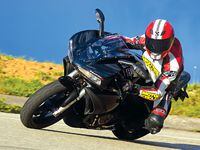

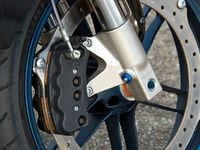
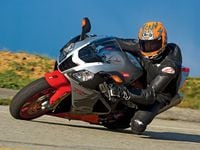
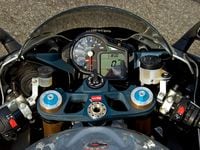



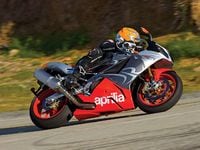
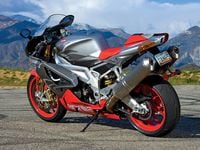

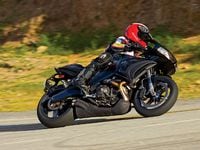

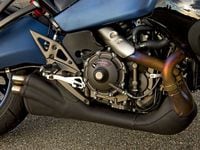


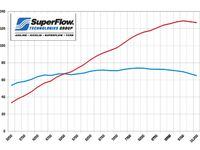


/cloudfront-us-east-1.images.arcpublishing.com/octane/JRSFLB2645FVNOQAZCKC5LNJY4.jpg)
/cloudfront-us-east-1.images.arcpublishing.com/octane/ITNLTIU5QZARHO733XP4EBTNVE.jpg)
/cloudfront-us-east-1.images.arcpublishing.com/octane/VZZXJQ6U3FESFPZCBVXKFSUG4A.jpg)
/cloudfront-us-east-1.images.arcpublishing.com/octane/QCZEPHQAMRHZPLHTDJBIJVWL3M.jpg)
/cloudfront-us-east-1.images.arcpublishing.com/octane/HXOUJXQWA5HBHGRO3EMJIGFMVI.jpg)

/cloudfront-us-east-1.images.arcpublishing.com/octane/3TIWWRV4JBBOLDVGRYECVVTA7Y.jpg)
/cloudfront-us-east-1.images.arcpublishing.com/octane/KIX5O23D5NAIBGFXBN3327DKZU.jpg)
/cloudfront-us-east-1.images.arcpublishing.com/octane/7GJYDUIPXRGMTMQKN6ONYOLBOU.jpg)
/cloudfront-us-east-1.images.arcpublishing.com/octane/MUQLOVLL2ZDGFH25ILABNBXKTI.jpg)
/cloudfront-us-east-1.images.arcpublishing.com/octane/TNOU5DNE2BC57MFPMGN2EIDXAM.jpg)
/cloudfront-us-east-1.images.arcpublishing.com/octane/GTCXACQGJ5HAPDTGWUQKDEH44E.jpg)
/cloudfront-us-east-1.images.arcpublishing.com/octane/S35YGSEMEZB4BLTDJTSZPF4GLA.jpg)
/cloudfront-us-east-1.images.arcpublishing.com/octane/5UOT6HPX2JFMRJAX6EH45AR4MQ.jpg)
/cloudfront-us-east-1.images.arcpublishing.com/octane/OKWOJWAKP5EP3OACCRRWPCIX2Q.jpg)
/cloudfront-us-east-1.images.arcpublishing.com/octane/2WF3SCE3NFBQXLDNJM7KMXA45E.jpg)
/cloudfront-us-east-1.images.arcpublishing.com/octane/G4MG6OUCJNBSHIS2MVVOTPX65E.jpg)
/cloudfront-us-east-1.images.arcpublishing.com/octane/IIGGWFOTOJGB7DB6DGBXCCMTDY.jpg)
/cloudfront-us-east-1.images.arcpublishing.com/octane/QSTCM6AVEZA5JJBUXNIQ3DSOF4.jpg)
/cloudfront-us-east-1.images.arcpublishing.com/octane/U4I7G625B5DMLF2DVIJDFZVV6M.jpg)
/cloudfront-us-east-1.images.arcpublishing.com/octane/B6XD6LS6IVCQPIU6HXDJSM3FHY.jpg)
/cloudfront-us-east-1.images.arcpublishing.com/octane/ICL63FEDDRDTTMINYICCEYGMDA.jpg)
/cloudfront-us-east-1.images.arcpublishing.com/octane/FCGZHQXRBZFLBAPC5SDIQLVF4I.jpg)
/cloudfront-us-east-1.images.arcpublishing.com/octane/WNOB6LDOIFFHJKPSVIWDYUGOPM.jpg)